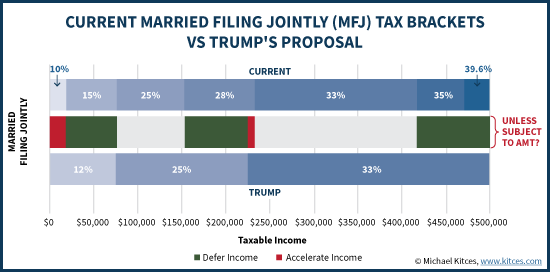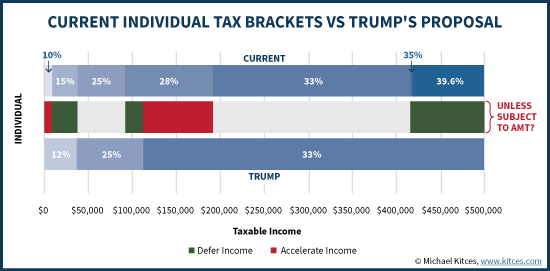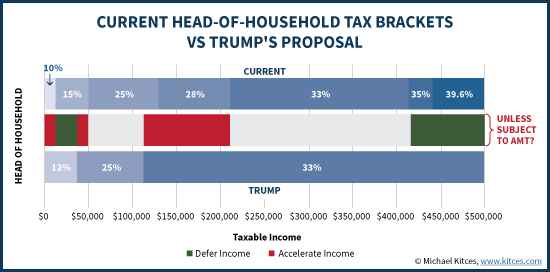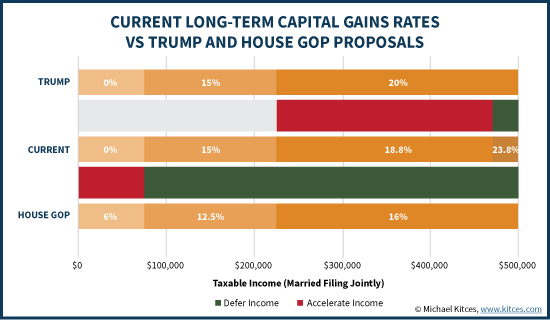Executive Summary
December is the season for end-of-year tax planning, and the looming potential for individual income tax reform in 2017 – with proposals from both President-Elect Trump, and the House GOP – makes planning in 2016 more complex, but also potentially more beneficial.
The reason is that the tax reform proposals could enact substantial changes to the tax brackets themselves – with the most likely outcome being lower tax rates for most people – which makes it especially appealing to defer income into next year (when rates may be reduced), and maximize deductions this year (at the currently more favorable rate).
In addition, the House GOP proposal would eliminate many popular itemized deductions (keeping only mortgage and charitable), which further enhances the benefit of claiming any/every deduction possible, before the end of the year (and while it still lasts!)
On the other hand, President Trump has proposed to leave itemized deductions in place, but cap them (at $100,000 for individuals and $200,000 for married couples), which wouldn’t impact most people, but could have profound implications for those making large charitable gifts. Ultimately, it’s possible – and even probable – that a carve-out for charitable giving could be implemented, if the deduction cap really is imposed next year. But just in case, those who are inclined to make large gifts might want to seriously consider contributing to a Donor Advised Fund before the end of 2016, in order to claim the deduction this year without a cap (to the extent otherwise permitted under the current charitable contribution rules), and rely more on Qualified Charitable Distributions from IRAs in the future to navigate the potential deduction cap!
Comparing Current Tax Brackets To Future Tax Reform Potential
Under current tax law, we have a 7-tax-bracket system, with rates starting at 10% and rising as high as 39.6%. By contrast, current tax reform proposals from both President Trump and the House Republicans would simplify and compress the tax brackets in 2017 down to just three: 12%, 25%, and 33%.
To understand the implications, we can line up a comparison of the income thresholds on the current tax brackets, versus the proposed ones (at least under President Trump’s proposal, which specifically identifies the potential bracket thresholds), and see where and how taxpayers may be impacted.
For married couples, the good news is that 2017 tax reform is likely to be favorable at virtually any/every income level. The 15% bracket would drop to 12%, the 28% bracket would drop to 25%, and the 35% and 39.6% rates would drop to a maximum of “just” 33%. The only adverse impact would be the bottom 10% tax bracket lifting up to 12%, but given that bracket only applies to the first $18,550 of income, a 2% increase in tax rates is just $371 of additional taxes (which would be more-than-offset for most because of tax bracket savings in the 15%-and-higher brackets, and/or the expanded standard deduction also proposed for next year).
The relative changes for married couples are shown in the chart below, where areas shaded green are income levels that would see a decrease in tax reforms under President Trump’s proposed reforms, while the red zone would see a modest increase (and the remaining income levels would simply pay the same rate they do now).

For individuals, the shifts are similar, but not quite as well aligned. The reason is that under Trump’s proposal, the so-called “marriage penalty” (where dual-income couples face higher tax rates than they would filing as individuals) would be eliminated by making the married couple brackets exactly double the individual brackets. Right now, though, there is only limited marriage penalty relief for anyone facing 25%+ tax rates. Which means the tax reform transition would expand the 25% bracket, but replace most of the 28% bracket with a new 33% rate, effectively amounting to a tax bracket increase for a large swath of individuals in the 28% bracket (from roughly $112,000 to $192,000 for taxable income). At the upper end, the elimination of the 35% tax bracket (albeit miniscule) and the 39.6% bracket would still produce tax rate savings.

Timing End-Of-Year Income For Potential Tax Reform
The significance of looming tax reform is that ultimately, good tax planning is done based on current versus future marginal tax rates – and if we “know” there’s at least a high likelihood that tax rates will change next year with legislation, it creates an opportunity to act.
For those who are in the “green zone” – where tax rates will potentially be lower next year than this year – end-of-year tax planning becomes very simple: try to defer any income possible, and push it out to the lower tax rate year next year.
Of course, the reality is that deferring income is something many people try to do already, as no one likes to pay taxes any earlier than they absolutely have to. But the potential for tax reform next year makes tax deferral even more valuable, especially at the top tax bracket, where the tax rate savings is the most significant (a potential 6.6% decrease in the tax rate).
Thus, small business owners and consultants who have flexibility about when they get paid might try even harder to push payment receipts into next year. Those who are retired and taking IRA distributions might minimize withdrawals at the end of this year (beyond any required minimum distributions that must be taken), and withdraw next year instead. For anyone taking their first RMD this year (the year in which they turn 70 ½), consider whether it really would be more beneficial to defer until the April 1 deadline and take the first RMD in the first quarter of next year (on top of the second RMD that would be due next year).
Similarly, doing Roth conversions are less valuable this year, if next year’s marginal tax rate will be lower, so be cautious about doing Roth conversions in the green zone (e.g., married couples in the 28%, 35%, or 39.6% brackets).
On the other hand, some individuals may still find that it’s appealing to accelerate income, either because of the looming tax reform changes, or despite them.
For instance, those filling the 25% bracket with partial Roth conversions may still wish to do so (as they’ll still be in the 25% bracket next year). Partial Roth conversions to fill the 15% bracket will likely also still be appealing, as while it’s possible the rate will drop to just 12% next year, for those in the 15% bracket the greater risk is usually that the IRA will compound to the point that their future RMDs drive them up into higher brackets anyway; in other words, it’s not about 15% now versus 12% next year, but doing a partial conversion at 15% this year and 12% next year (and the year after, and the year after) to avoid the 25% bracket when RMDs kick in later.
In addition, individuals who are in the top half of the 28% bracket might actually accelerate income in 2016, because tax reform would actually lead to a higher tax bracket in 2017. And for those at very high income levels (e.g., $500,000+), accelerating income into 2016 may be appealing because they’re actually subject to AMT, which technically has a top marginal tax rate of only 28% after passing the AMT “bump zone” (better than next year’s top 33% rate).
It’s also important to recognize that those who are filing as “head of household”, future tax rates may be less favorable next year, as the filing status would be eliminated under both Trump and GOP tax reform proposals, which would cause some of the current 15% bracket to be pushed up to 25%, and the entire 28% bracket would be lifted up to 33%.

Similarly, large families that have 4+ children may also face somewhat higher tax rates next year, as current tax reform proposals would eliminate personal exemptions for each dependent, in exchange for a single large standard deduction that applies uniformly for individuals and married couples regardless of family size. For most, the new standard deduction will be advantageous, but for large families with a lot of dependent exemptions, it would be less favorable, and fewer deductions will generally result in people having more income subject to higher marginal tax rates.
End-Of-Year Capital Gains And Tax Loss Harvesting
When it comes to portfolios and the taxation of investments, most of the standard strategies for capital gains planning still apply, regardless of looming tax reform.
Those at top capital gains rates of 23.8% (including the 3.8% Medicare surtax) will still want to harvest losses and defer gains, while those in the bottom tax brackets want to harvest capital gains at the 0% rate.
And capital gains harvesting may remain appealing even in the 15% bracket, if the capital gains are adding up to “too much” in the future, as while President Trump has proposed to repeal the 3.8% Medicare surtax in 2017, his new 20% capital gains bracket would still increase capital gains rates next year for anyone paying 18.8% today. Which means the potential to harvest capital gains this year at 15% to avoid next year’s 20% would be valuable.
On the other hand, it’s probably not worthwhile to harvest at 18.8% capital gains rates just to avoid 20% next year, as the House GOP proposal would slightly decrease the 18.8% rate, down to “just” 16.5%, making the outcome a toss-up.
For those in the top tax brackets, though, it’s especially appealing to push capital gains out next year, when top rates may drop from 23.8% to “just” 20% (Trump) or even 16.5% (House GOP), without the 3.8% net investment income tax.

Timing Deductions And The Potential 2017 Elimination Or Caps On Itemized Deductions
In addition to deferring income until next year (when rates may be lower), looming tax reform would also make it more valuable to accelerate deductions into the current year. After all, if next year’s tax rates will be lower than this year’s rates, then tax deductions will be less valuable next year than they are this year.
Accordingly, high-income small business owners might accelerate additional business purchases by end of year, as it’s potentially on sale an “extra” 6.6% to buy this year (with a top rate dropping from 39.6% to only 33%). Those in the 28% bracket could get a 3% “discount” as well (given that their rate may only be 25% next year). More generally, anyone in a “red zone” (from Figures 1 and 2, above) whose tax rate is projected to be lower next year, would benefit from accelerating deductions into the current year.
Other flexible deductions to consider before the end of the year include:
- Paying fourth quarter state estimated taxes by December 31st, instead of in early January by the deadline (though notably, this won’t help anyone who is already subject to the AMT this year)
- Paying large medical expenses before the end of the year
- Maximizing any planned charitable contributions before the end of the year (particularly if the plan is to donate appreciated securities and not do a Qualified Charitable Distribution from an IRA)
Impact Of An Increased Standard Deduction In 2017
Furthermore, it’s notable that the proposals to increase the standard deduction next year – to $12,000 for individuals and $24,000 for married couples under the House GOP plan, or to $15,000 and $30,000, respectively, under President Trump’s plan – could actually eliminate itemized deductions for many in 2017 and beyond. By comparison, the current thresholds are only $6,300 for individuals and $12,600 for married couples in 2016.
Which means individuals between $6,300 and $15,000 of deductions, or married couples between $12,600 and $30,000, could “lose” itemized deductions next year, and thus should be especially focused on maximizing those deductions in the current year while they can still get them. (Other deductions, that are less flexible – such as the mortgage interest deduction – may simply become less relevant altogether in the future, as a wide swath of consumer mortgages do not cost enough in interest to clear the standard deduction in the future.)
Potential Elimination Of, Or Cap On, Itemized Deductions
Notably, though, perhaps the biggest potential challenge in planning for deductions, are the proposals that could cap deductions, or outright eliminate many of them, in 2017 and beyond. President Trump’s proposal would cap cumulative itemized deductions at $100,000 for individuals, and $200,000 for married couples, while the House GOP plan would eliminate virtually all itemized deductions entirely, except for the charitable and mortgage interest deductions (though those would remain without any caps).
These potential changes, if enacted, would have far more profound implications. The House GOP potential for elimination of every deduction besides charitable and mortgage means almost any other deduction that’s possible might be accelerated into 2016, because it could be gone next year altogether, from the deductions for state and local income taxes, sales taxes, or property taxes, to the deductions for medical expenses, as well as all miscellaneous itemized deductions (which includes the deduction for investment advisory fees paid from taxable accounts!). Which makes it especially important to pay any/all of those expenses by December 31st, and claim them as deductions if/where possible (though again, virtually none of these will be deductible anyway for those subject to the AMT).
On the other hand, President Trump’s proposal to cap deductions would have different implications. In practice, the caps wouldn’t hit most people at all (as most don’t even clear the new standard deduction, much less the potential caps that are nearly 7X higher). However, the cap could be especially problematic for those who are considering big charitable contributions in the future, where single-year large contributions could end out on the wrong side of the proposed cap. Notably, it’s still possible that even if Trump’s cap is implemented, that there will be a carve-out exception for charitable contributions – while it wasn’t part of Trump’s original plan, the reality is that charitable contributions are often exempted from other limitations, because the reality is that charitable giving both accomplishes a social good, and often fulfills functions that government would have had to do anyway (which means tax expenditures to subsidize charitable giving end out with a net cost that is much lower).
Nonetheless, the potential that an itemized deductions cap could limit charitable contributions – as currently proposed – means those considering sizable charitable giving in the future should seriously consider a major contribution to a Donor Advised Fund this year, while the full charitable contribution deductions are in place (not to mention claiming the deduction at current tax brackets) . Of course, large contributions still have to navigate the charitable contribution deduction limits under the current rules – where a DAF is a “50% charity” (or 30% for donating appreciated securities) – but even a large contribution with a partial carryforward may fare better than making the whole contribution in the future with a deduction cap. Future years’ charitable giving could then be supplemented with Qualified Charitable Distributions from IRAs (which at least under current rules, operate outside the itemized deduction rules, and therefore wouldn’t be subject to the itemized deduction cap, unless those rules are changed as well).
Ultimately, it remains to be seen what kind of tax reform really is implemented (or not) next year, as even with a Republican clean sweep, there are still substantial differences between the Trump and House GOP plans that must be reconciled, and the Democrats still have enough votes to filibuster the Senate, which means at least some bipartisan compromise may be necessary as well.
Nonetheless, the existing template for tax reform is enough to allow for – and encourage – at least some tax planning considerations at the margin with year-end approaching, primarily focused on deferring income (as tax reform leading to at least somewhat lower rates in most situations seems likely), and accelerating deductions (given both potential rate changes, and potential limitations on deductions). And so whether it’s executing a partial Roth conversion, harvesting capital gains and losses, or making a large contribution to a donor-advised fund, be certain to evaluate end-of-year tax planning opportunities before it’s too late!
So what do you think? Will 2017 income tax reform happen? Will deductions be capped, or (mostly) eliminated? What tax strategies are you looking at doing by year end? Please share your thoughts in the comments below!





Michael,
In postcard submission, line 3 covers what goes into deferred savings plans (IRA, 401k), but what is done about funds coming out of these savings plans (Form 8606 items, e.g. Roth conversions) and what happens to “preferences” like the Net Unrealized Appreciation (NUA) 401k rollout.
I have, for example, fortunately already used NUA at recent retirement. This is one of those complications that people near retirement may have planned on. Are they going to have to grandfather some of these lest they face AARP backlash.
Thanks,
Ed
Question: There is reference to accelerating income since the AMT tax rate is 28% but isn’t that misleading because the effective rate increases to 35% for every dollar of ordinary income when you are subject to the AMT because you end of reducing the AMT exemption at the same time?
That’s why the article specifically states “after passing the AMT bump zone”, which is the income range in which the AMT exemption is phased out. See hyperlinked article for further detail. 🙂
– Michael
Should the 2017 below actually be 2016?
The House GOP potential for elimination of every deduction
besides charitable and mortgage means almost any other deduction that’s
possible might be accelerated into 2017, because it could be gone next year
altogether, from the deductions for state and local income taxes, sales taxes,
or property taxes, to the deductions for medical expenses, as well as all
miscellaneous itemized deductions (which includes the deduction for investment advisory fees paid from
taxable accounts!).
Eek, yes you’re right James.
Updated with a correction now! Thank you!
– Michael
Mike,
A very good discussion, two comments from my perspective. Recharacterizing a portion of the Roth conversion will enable clients/advisers to manipulate the conversion amount to take advantage of preferential marginal rates to the $. Secondly, prepaying state taxes for those in AMT may be advisable, as we know there will be a NIIT benefit (3.8%) this year. For payments otherwise due on 1/15/17 that’s a return of 3.8% over a 2 week period. I always enjoy your articles.
Happy Holidays,
Mike Rubin
Thank you for another thoughtful article. A few questions and comments:
1. What’s the amount of the tax cut for couples/individuals currently in the 33% tax bracket? This is the new top bracket proposed by Trump and the GOP blueprint. For most advisors this is the sweet spot for clients (approximately $231-431k taxable income for joint filers). It seems that the real tax cut is for those in higher tax brackets (39.6% begins at about 467k).
2. If the goal is three tax brackets, tax reform should rethink the thresholds for the three brackets. Is there any serious discussion of the incomes for each bracket or it’s just “let’s cut off the top two tax brackets”? To help the upper middle class, who will more likely spend the tax cut and stimulate the economy, it would be better for the 33% bracket to start where the 39.6% now starts. This would widen the 25% bracket and help more clients.
3. For clients looking at selling stock this year compared to next, given the unanticipated stock price run up after the election, you have to model both for tax rate changes (assuming the Medicare surtax is and isn’t repealed and this repeal is effective for tax year 2017) and stock price changes.
4. There are not that many areas where individuals working for another company can control the year in which they receive taxable income. Those with employee stock options do have that flexibility in when they exercise options. An article on year-end planning with stock options that consider rate changes is featured on the home page http://www.myStockOptions.com.
I was hoping to find information in your article about the elimination of personal exemptions (part of Trump’s tax plan) and how that would effect taxes. A family of 4 with a stay-at-home parent would lose $16,200 of personal exemptions. Let’s say this family falls in the 25% bracket. If this family currently had $20,000 of itemized deductions, wouldn’t they be taxed more under Trump?
The family of 4 with $20,000 of itemized deductions would have $36,200 of total deductions (exemptions plus itemized), and Trump’s proposal would be an expanded standard deduction of $30,000. So in this case, you’d end out with about $6,200 less in deductions. At a 25% rate, that’s a roughly $1,550 tax increase.
On the flip side, the Trump proposal would consolidate the (small) 10% bracket and the (bigger) 15% bracket into a single 12% bracket, which for a married couple would reduce in a roughly $1,330 tax savings.
So the net result is that it might increase the family’s tax liability by about $200. Though it’s worth noting that Trump’s proposal has additional tax deductions for child care for children under 13, including allowing a family with a stay-at-home parent to still be eligible for the child care deduction for implied expenses, so a family of four with young children would likely still come out ahead.
– Michael
I don’t see it here but I have been seeing a strategy pop up that might work for some, including me. Correct me if I’m wrong and assuming, like me, you are in the 28% bracket and/or might be hovering around the 33% bracket if these changes take place, you could talk your employer into setting you up as an independent contractor. If another of his proposals, that Sole Proprietorships get taxed at the other proposed lower 15% Corporate rate, wouldn’t that be a good move? Even with the added SE taxes, unemployment insurance and self paid medical insurance; for me, when I run the numbers it works out pretty good. I presently have a daily commute to my office and I can’t take the mileage deduction but if I were an independent, I could call that “travel” instead of a commute and either take the standard deduction or use the worksheets and take deductions for the vehicle depreciation, tolls, gas, maintenance, etc. For me this would also technically be a termination of employment which would free up my 401k, at which time i could either take the hit and use the money somewhere (safe haven assets) or maybe setup and roll that over into a solo 401, since I would now have a LLC/S Corp or other entity. Also, wouldn’t it no longer make sense to have to set up an S Corp to get the lower nominal salary with the balance of compensation being made up in dividends? If the Corporate rate ends up being 15% and he enacts that sole proprietors get the corporate rate, I could set up a simple D.B.A or LLC and have the whole thing taxed at 15%? I could also hire my wife which would open up the availability of group health insurance for the “company”, pay her a nominal salary and then get on her “family plan” and the cost of the insurance would be fully deductible. None of these thoughts are of my own origination but I thought I would run these by anyone here who hasn’t seen this approach elsewhere. I am seriously considering this approach myself.
Here’s my question to you my husband is union between the both of us we make around 160,000.00 a year. My husband travels he lives out of state around 9 months a year. Will he still get to deduct housing, mileage,and other expenses? Around 10,000.00 a year.